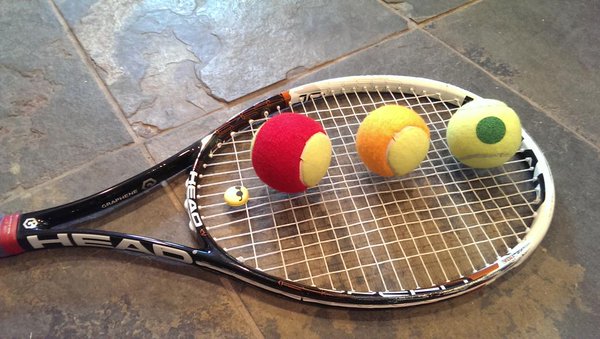|
Kel and I regularly attend junior tournaments to support our players and check on their progress in competitive matches. We enjoy seeing the kids in action, and talking with the parents, with whom we don't get much time during the week because we are on court with the kids. We get asked lots of questions, ranging from how many times a week should a child play, to what is the best racquet for a junior player, and why are we such big fans of the Red/Orange/Green/Yellow (ROGY) ball progression.
Since Kel and I started coaching (nearly 20 years ago!), the approach to teaching young tennis players has changed. The systematic use of the ROGY Balls, and the developmental steps represented by each color, allows coaches to build the fundamental skills needed to take a player to the highest level possible. Using smaller courts, softer balls, and racquets designed for the size and strength of young players, you can successfully introduce kids to the sport at a younger age, and continuously adapt the game as they grow, physically and skills-wise. In addition to appropriate equipment, the structure of training needs to be tailored for children. Long lines with kids waiting 2-3 minutes to hit one ball? It doesn't work. Practice needs to have a purpose and a fitting structure. We work to have the kids constantly moving and interacting with each other. We also strive to make it fun: playing games, rallying, and target practice for ground strokes and serves. Why are we such big fans of the ROGY progression? Simply, it is the best way to develop tennis players. It allows kids to start tennis (successfully) at a younger age—an 6-year-old kid should not be hitting from the 72-foot baseline with a Yellow Ball! It also establishes milestones of development, ensuring the fundamental skills are learned before moving on. And while it may seem counter-intuitive (and is often unpopular for those know don't understand ROGY), it encourages a child to move through the stages more methodically, which allows skills to be acquired more rapidly. Hitting from the 72-foot baseline at a young age is NOT an accomplishment—it doesn't mean the child is more advanced! Using the right grips, with the best swing shape, and good biomechanics, on a smaller court, with a slower ball will allow your child to become a far more complete tennis player in the long term. I can categorically say that the best players I have developed have purposely taken their time through every phase of the ROGY progression. Don't sprint ahead, as you'll only get overtaken in the end! Thanks for reading, and thanks for your support. Comments are closed.
|
Matt's PointMatt's Point (get it? Match Point!) is Matt's blog covering all the goings-on at IJP Tennis. Archives
July 2024
Categories |


 RSS Feed
RSS Feed